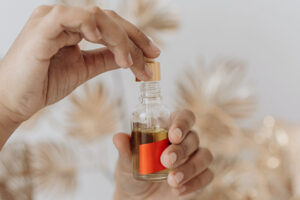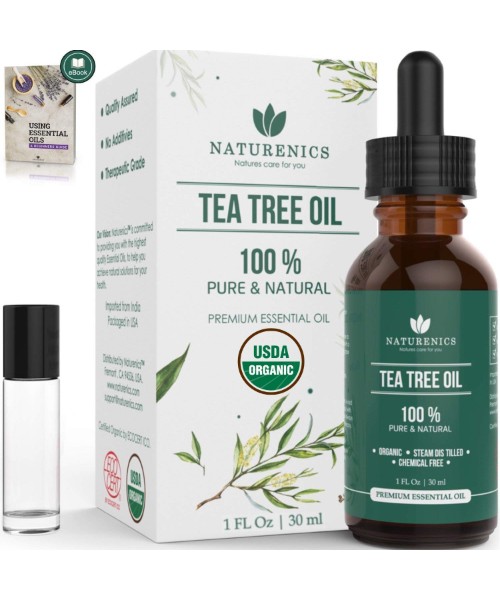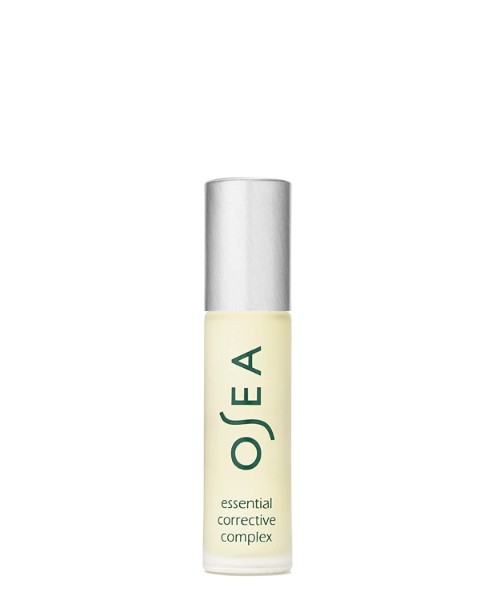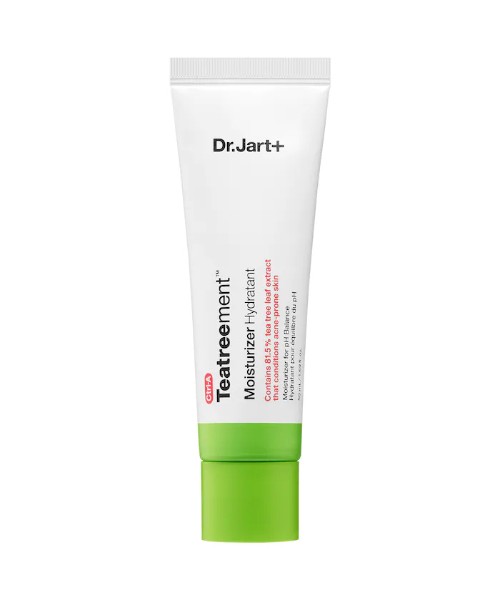While there’s a lot of natural acne remedies out there, tea tree oil is probably the most talked about. You may have read about this essential oil online, or even seen it used in skincare products. That begs the question: does tea tree oil help acne, and is it a suitable tool for keeping breakouts at bay long term? We’ll talk about everything you need to know about using tea tree oil for acne.
What is Tea Tree Oil?
Tea tree oil (which is also referred to as melaleuca oil) is an essential oil. This essential oil is created by steaming the leaves of the tea tree, which is native to Australia. It has been used as medicine by the Aboriginal people of Australia for centuries.
Tea tree oil contains a compound called terpinen-4-ol. This compound is largely responsible for the oil’s anti-inflammatory and antimicrobial benefits, which we’ll talk about in more detail below.
Today, it’s easy to find 100% undiluted tea tree oil on the market. You can also find a variety of products (including skincare solutions) that formulate tea tree oil alongside other ingredients.
How Does Tea Tree Oil Affect The Skin?
When applied topically, tea tree oil can provide a lot of benefits for the skin. Since it has anti-inflammatory properties, it can help minimize redness and relieve pain and irritation. This oil also has antiviral, antifungal, and antibacterial effects.
It should be noted that tea tree oil does have some side effects (which we’ll talk more about later), especially if you apply it too frequently or use an undiluted formula. When using 100% tea tree oil topically, it’s important to properly dilute it so that you get the benefits without the negative side effects.
How Does Tea Tree Oil Impact Acne?
As you may have guessed, since tea tree oil has anti-inflammatory and antibacterial properties, it’s an effective solution against acne. What’s particularly impressive is that it works to minimize and prevent multiple forms of acne, including comedonal breakouts (such as whiteheads and blackheads) and inflammatory pimples.
Tea tree oil treats acne from multiple angles. It’s able to calm redness and irritation related to current blemishes to minimize their severity, while also killing bacteria to reduce the total number of blemishes.
You don’t have to take my word for it – tea tree oil has the science to back it up. When comparing the effects of benzoyl peroxide versus tea tree oil against acne, researchers found that tea tree oil could be just as effective, but caused significantly less dryness, itchiness, and skin scaling than benzoyl peroxide. Benzoyl peroxide did, however, lead to less oiliness.
There’s also another small study worth highlighting that solely looked at tea tree oil for acne. After observing participants who applied tea tree oil twice daily for 12 weeks, researchers found that this oil provided significant improvements in mild to moderate acne.
It should be noted that tea tree oil may not work as quickly as benzoyl peroxide, since it kills bacteria at a slower rate. That said, since it’s a gentler solution and has the added anti-inflammatory effects, it’s still a great option worth considering – particularly if you have more sensitive skin.
Does Tea Tree Oil Help Acne Scars?
While tea tree oil has been proven to be an effective solution against acne, there’s little conclusive research into whether it can help with acne scars. It’s unlikely that applying tea tree oil will directly help diminish the appearance of acne scars. That said, it can help prevent acne scars by blocking scar-causing breakouts from forming in the first place.
If you’re looking to minimize acne scars, you’ll want to ensure you’re sticking to an effective routine that includes an appropriate face wash and treatments known to diminish breakouts and fade scars.
Does Tea Tree Oil Clog Pores?
No need to worry – tea tree oil is non-comedogenic. This means that it doesn’t clog pores, so you shouldn’t be concerned that it will worsen breakouts.
How To Perform a Patch Test With Tea Tree Oil
It’s always smart to do a patch test when considering using new skincare products. This will help you monitor how your skin will react so that you can avoid using anything that may end up doing more harm than good.
Here’s how you can perform a patch test with tea tree oil:
- Pick an inconspicuous area of the skin to do the patch test (the inside of your elbow is a suitable spot). Thoroughly cleanse the area, and then pat dry.
- Apply an even layer of a diluted tea tree oil solution (whatever you would be using on your face) to a small area of the skin.
- If you experience any immediate negative side effects (such as intense burning or itching), wash the oil off. Otherwise, leave the solution on and cover the skin with a bandage. Leave the bandage on for 48 hours.
- After 48 hours, remove the bandage and look for signs of sensitivity on the skin, such as redness, itchiness, burning, or swelling. If you notice these signs, tea tree oil likely isn’t a suitable option for you.
Types of Tea Tree Oil
As mentioned, when using a pure tea tree oil to treat acne, diluting is an absolute must in order to prevent irritation and dryness. You can either dilute with water, or use an oil that is safe for acne-prone skin.
Diluting with an oil is a great way to go, as the oil can moisturize the skin and further counteract any drying effects of the tea tree oil. Some great oils that are non-comedogenic include hemp seed oil, squalane, and argan oil.
When picking out a pure tea tree oil, you should ensure the product you’re choosing is genuinely 100% tea tree oil. Some products on the market are mixed with other oils or fragrances that can actually be bad for acne-prone skin. Look at the ingredients label to make sure tea tree oil is the only ingredient.
If diluting your tea tree oil sounds a bit too cumbersome, buying a skincare product that blends tea tree oil with other skincare ingredients will be an easier option. You’ll find a couple recommendations in the products section later in this article.
How to Apply Tea Tree Oil to Acne
If you’re thinking of using pure tea tree oil to treat a blemish, there are a few key steps you’ll need to take in order to safely use this natural solution. You’ll either dilute with water or with oil. Here are the steps for both options:
Applying Tea Tree Oil Diluted with Water
- Thoroughly cleanse the skin and pat dry.
- Dampen a Q tip, and then swipe it inside the tea tree oil lid or on the dropper to allow it to absorb some of the oil.
- Gently apply the solution directly on your blemish with the Q tip.
- Allow the solution to dry, and then follow up with a moisturizer, and sunscreen during the day (note: if the solution is causing some irritation, you might also choose to apply moisturizer first to create more of a buffer).
- Repeat this process both morning and night as the blemish heals.
Applying Tea Tree Oil Diluted with Oil
- Thoroughly cleanse the skin and pat dry.
- Combine 1 to 2 drops of 100% pure tea tree oil with at least 12 drops of your carrier oil of choice.
- Using a Q tip or your fingertips, gently apply the diluted solution onto your blemish.
- Allow the solution to absorb, and then follow up with a moisturizer, and sunscreen during the day.
- Repeat this process both morning and night as the blemish heals.
Tea Tree Oil Side Effects
There’s a common misconception that natural solutions won’t cause any negative side effects, but that couldn’t be further from the truth. Just as with any other product you apply to your skin, you need to use tea tree oil with caution.
There are some side effects associated with tea tree oil worth noting. This includes redness, irritation, itchiness, and swelling. Do a patch test to ensure your skin tolerates tea tree oil, and always dilute 100% pure tea tree oil before applying it to the skin to minimize the risk of negative side effects.
Best Tea Tree Oil Products For Acne
If you want to try using tea tree oil to treat acne, here are some of the best products. I’ve included a pure tea tree oil, as well as skincare products that are formulated with this oil.
Best Pure Tea Tree Oil:
Naturenics – Tea Tree Essential Oil
This tea tree oil is organic and completely free of additional ingredients. It’s 100% pure, and can serve a variety of different purposes.
GoodGlow Score
Effective Anti-Acne
When diluted, oil can be used to treat blemishes
100% Pure Organic Tea Tree Oil
This oil has been distilled and extracted from the very best leaves from the tea tree plant, using the traditional steam distillation method
Clean Ingredients
No Sulfates, No Parabens, Gluten Free
Skin Type
Suitable for all skin types
100% Pure Organic Tea Tree Oil
If you’re looking for a pure tea tree oil, it doesn’t get better than the Naturenics Tea Tree Essential Oil. This formula is USDA-certified organic, and doesn’t contain any additional ingredients. That means it’s completely pure and free of parabens, sulfates, and pore-clogging ingredients. When diluted, it can be safely used as a topical solution against acne.
The Naturenics Tea Tree Essential Oil comes in a one-ounce dropper bottle. Since you only need to use a very small amount when treating acne, this bottle can last a very long time.
Best Facial Oil:
Osea – Essential Corrective Complex
This facial oil from Osea is an excellent choice for anyone with oily and acne-prone skin looking to calm blemishes and reduce shine. It combines tea tree oil with other essential oils that clarify the skin for a clearer complexion.
GoodGlow Score
Moisturizing
Jojoba and macadamia seed oils moisturize the skin
Clarifying
Tea tree oil, white thyme, juniper, and additional essential oils fight breakouts and refine pores
Vegan-friendly
100% vegan and cruelty-free formula
Skin Type
Made for oily and acne-prone skin
Natural Derived Ingredients: Simmondsia Chinensis (Jojoba) Seed Oil, Macadamia Ternifolia (Macadamia) Seed Oil, Sesamum Indicum (Sesame) Seed Oil, Melaleuca Alternifolia (Tea Tree) Leaf Oil, Rosmarinus (Rosemary) Leaf Oil, Lavandula Angustifolia (Lavender) Oil, Thymus Vulgaris (White Thyme) Oil, Citrus Paradisi (Grapefruit) Peel Oil, Juniperus Communis (Juniper) Leaf Oil, Cupressus Sempervirens (Cypress) Seed Oil, Tocopherol
For those looking for an oil that blends tea tree oil with other ingredients, the Osea Essential Corrective Complex is an excellent option. This multi-tasking facial oil was made specifically for acneic and oily skin, and helps to fight breakouts while refining pores and reducing shine. It can be applied directly to active blemishes, or can be used in acne-prone areas of the face to prevent breakouts.
In addition to tea tree oil, this Osea solution contains additional essential oils that clarify the skin, including white thyme, lavender, and juniper oils. Other oils nourish and moisturize the skin, including jojoba seed and macadamia seed oils.
What’s also nice about this face oil is the packaging. It comes with a rollerball applicator that makes it super easy to apply. This formula is vegan and cruelty-free, and made with clean ingredients.
Best Tea Tree Oil Moisturizer:
Dr. Jart – Teatreement Moisturizer
This Dr. Jart tea tree oil moisturizer is formulated to minimize breakouts while calming and hydrating the skin for a clear and comfortable complexion.
GoodGlow Score
Lightweight
Moisturizer is made to adequately hydrate without feeling greasy on the skin
Calming
Chamomile flower extract, aloe vera extract, and additional ingredients calm the skin
Fights Acne
Both an extract and oil from the tea tree leaf work to treat and prevent breakouts
Skin Type
Suitable for normal to oily skin that’s prone to acne
Melaleuca Alternifolia (Tea Tree) Leaf Extract, Glycerin, Ethylhexyl Stearate, Methylpropanediol, Niacinamide, Trehalose, Methyl Trimethicone, Cetearyl Glucoside, Sorbitan Olivate, 1,2-Hexanediol, Water/Eau, Cetearyl Alcohol, Xanthan Gum, Centella Asiatica Extract, Ficus Carica (Fig) Fruit Extract, Eclipta Prostrata Leaf Extract, Laminaria Japonica Extract, Gloiopeltis Furcata Extract, Allantoin, Aloe Barbadensis Leaf Extract, Anthemis Nobilis Flower Extract, Butylene Glycol, Camellia Sinensis Leaf Extract, Carthamus Tinctorius (Safflower) Seed Oil, Ethylhexylglycerin, Glycyrrhiza Glabra (Licorice) Rhizome/Root, Hamamelis Virginiana (Witch Hazel) Extract, Melaleuca Alternifolia (tea Tree) Leaf Oil, Amaranthus Caudatus Seed Extract, Ulmus Davidiana Root Extract, Cinnamomum Zeylanicum Bark Extract, Pinus Pinaster Bark Extract, Hydrogenated Lecithin, Sodium Polyacryloyldimethyl Taurate, Sorbitan Stearate, Caprylic/Capric Triglyceride, Glycine Soja (Soybean) Sterols, Linoleic Acid, Phospholipids, Disodium EDTA, Fructooligosacchadrides, Salicylic Acid, Beta-Glucan, Hydrolyzed Hyaluronic Acid, Capryloyl Glycine, Ceramide NP, Hexylene Glycol, Camphor Silica, Sarcosine, 4-Terpineol, Methyl Methacrylate Crosspolymer.
A moisturizer that’s made with tea tree oil can be a great option for anyone looking for a product that gently prevents breakouts. One of the best options on the market is the Dr. Jart+ Teatreement Moisturizer, which is made specifically for the needs of oilier skin that’s prone to breakouts.
This lightweight moisturizer is made with the company’s Teatreetment Solution, which combines tea tree leaf extract, tea tree leaf oil, and 4-terpineol. This solution targets blemishes and removes impurities from the skin to prevent future breakouts. A low concentration of salicylic acid also works to further minimize acne and reduce shine for a clearer, less oily complexion.
An additional blend of ingredients ensure the complexion stays calm and adequately hydrated. This includes aloe vera extract, green tea extract, and chamomile flower extract.
Alternatives to Tea Tree Oil for Acne
If you don’t see the desired effects from using tea tree oil – or you are simply looking for an alternate option – there are plenty of other routes you can take.
Benzoyl peroxide and salicylic acid are two science-backed ingredients that are highly effective solutions against acne. You’ll find them used in cleansers, acne treatments, serums, and masks.
In more persistent cases, you may also consider meeting with a dermatologist to consider prescription options. They may suggest topical solutions (such as a stronger prescription-strength retinoid) or oral solutions (such as antibiotics, isotretinoin, or birth control pills).
How Often Should Tea Tree Oil Be Applied
In general, tea tree oil can safely be applied twice per day as a blemish is healing. However, you should always pay attention to how your skin reacts and adjust as needed. If you experience mild negative side effects, it’s best to only apply tea tree oil once a day. Additionally, if you’re using a skincare product that’s made with tea tree oil, refer to the instructions for the most suitable course of action for that specific formula.
Can Tea Tree Oil Be Used For Skin Conditions Other Than Acne?
What’s particularly great about tea tree oil is that it can be used to treat a wide range of additional skin conditions. This means that a single bottle of pure tea tree oil can end up serving even more purposes than you initially imagined.
Since it has antifungal properties, this essential oil can help relieve the symptoms of athlete’s foot. The antiviral benefits of tea tree oil may also be beneficial for minimizing the severity of cold sores. These properties – along with the fact that the oil also provides anti-inflammatory effects – also make tea tree oil a beneficial tool for lessening the symptoms of eczema.
Tea tree oil is a good tool to have on hand after a day out in the sun, since it can soothe the skin and relieve pain. If you’re dealing with a sunburn, consider diluting it with aloe vera to really calm the skin.
When applied to the scalp, tea tree oil may also help minimize dandruff and seborrheic dermatitis, thanks to both its antifungal and anti-inflammatory properties.
FAQs
Yes, tea tree oil has antibacterial properties. This is largely why it’s an effective solution against many forms of acne. It can also help disinfect minor skin abrasions to prevent infection.
Yes, tea tree oil is anti-inflammatory. This makes it a beneficial natural solution for symptoms related to many skin conditions and concerns, including acne, sunburns, dandruff, and eczema.




